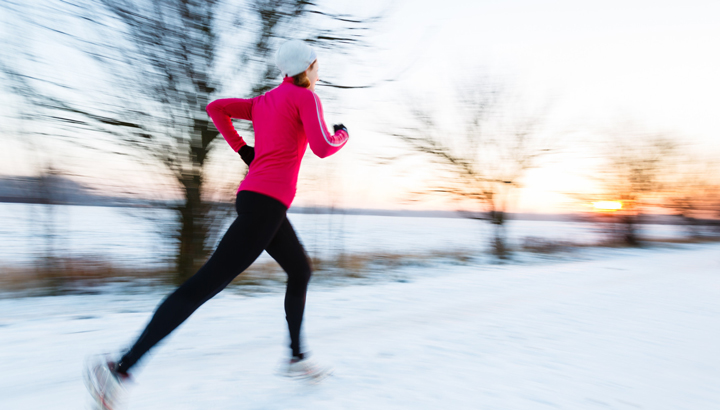Avoiding Cold Weather Injuries- By Russell Gunner
We are hitting midwinter and the truly crazy runners are starting to hit the blues and look forward to those hot 5 C days. Not many of us enjoy the bitterly cold workouts on a Sunday morning, especially when we seem to have more layers on than a whale has blubber.
Whatever the outdoor sport, the question remains: are we more prone to injuries or are our muscles too frozen to tear when it is this cold? There is no clear answer, but there are certainly a few tips and tricks we can try to avoid getting winter injuries and becoming a couch potatoe.
One of the first and most obvious tips is to layer your clothing properly. Use lightweight, wicking fibres as the innermost layer. Wicking fibres help take sweat away from your body. This can be very important during a long run or cross-country ski outing when you don’t want to get too hot or cold. Nobody wants frostbite, and this will usually only occur in the extremities. But this is no reason not to protect your main organs, especially for men. Add a good wind-breaking exercise jacket to help propel the external conditions away from your upper body.
Protecting your extremities is one of the most important things you need to do. It is a good idea to have a wicking layer for your socks and gloves as well. In the summer, we often exercise with thin socks to avoid athletes’ feet and help wick away moisture. In the winter, a good pair of thick socks made from synthetic fibres will help keep your toes warm, but at the same time perform the same function as the thin summer socks.
Remember that your head may be responsible for 40 per cent of your heat loss. A good exercise hat is essential. Make sure it’s small enough that if you start to overheat, you can put it in a pocket or hold onto it.
One of the toughest problems on short and snowy winter days is finding a good place to run. In the warmer times, we have several choices on what surface we can run on (paths, sidewalks, tracks, etc.). In the winter, however, these options are often covered in snow or ice.
Tips for running on the road
The road is usually the only clear option and, even then, extra caution must be taken. I don’t mind you walking into my office with a minor running injury but getting hit by a car is not on my list of acceptable winter injuries.
When running on the road, don’t forget that the pavement is cambered to allow for water runoff. You should be aware of this on your long runs. If you think about it, if you are constantly running against traffic, your right leg is stepping down a little more quickly and harder due to the uneven pavement. Switch up sides sometimes when you get to a quieter street to avoid this from happening. For cross-country skiing, any groomed flat trail is obviously the best surface but a few hills are always good to add some variety and different forms of training.
Black ice is also something that runners as well as drivers must watch for. Last year, I met up with a group for a 15-kilometre run early one Saturday morning. I knew there was a warning of black ice in the forecast, but until I got out there, I didn’t realize how bad it was. We started out the run more or less skating down the first hill, just hoping we didn’t fall and embarrass ourselves in front of the three lonely cars on the road. By the time we got onto some side streets, we had to run in the middle of the road where the car tires had warmed up the ice.
Not being the brightest creatures around, we continued on like we were expecting the temperature to rise by 20 degrees any minute. At the local coffee shop after the run, we all recounted how many times we slipped and said it was something we never wanted to do again. We were lucky, but if black ice is prevalent, you might want to think about sticking to the treadmill for a day.
Avoid speed work
Often in the winter, most athletes (yes, you’re an athlete!) tend to work mainly on maintenance and increasing the mileage slowly. The one thing I would recommend against is trying to do some speed work when it is cold, other than on the treadmill. It obviously takes longer for the muscles to warm up in the cold weather, and this in turn may cause them to not work at their required potential. The muscles that perform the quick and lasting contractions needed for sprint training need to be ready — otherwise, you run an increased risk of injury.
A good example I like to use with my patients is the “licorice” analogy. In the winter, if you take a piece of licorice outside for a few minutes, it will tend to freeze and get very stiff. If you then bring it back inside, watch how it becomes warm and more pliable. Your muscles will do the same thing in the cold weather.
Just because it is cold doesn’t mean that your body needs less fluid. You might feel that since you’re not sweating as much, you should be fine. Wrong! You obviously don’t need to replenish fluids to the same extent as on a hot day in the summer. But you do still sweat in the winter. Try going for a 10-km cross-country workout and tell me you don’t have to wring out your hat afterward. Depending upon the length of the workout, you may not need to carry some fluids with you: carrying around your sports drink on a very cold day could turn your hydrating drink into a frozen slushie. But have them ready right away when you’re done.
Enjoy those outdoor winter workouts, but make sure you are prepared for the worst. Don’t get stranded out on a -30 C day when you should have had one more layer and your body is feeling it. Believe me, I have done it and it takes all the fun out of your workout. As much fun as a -30 C workout can be.

